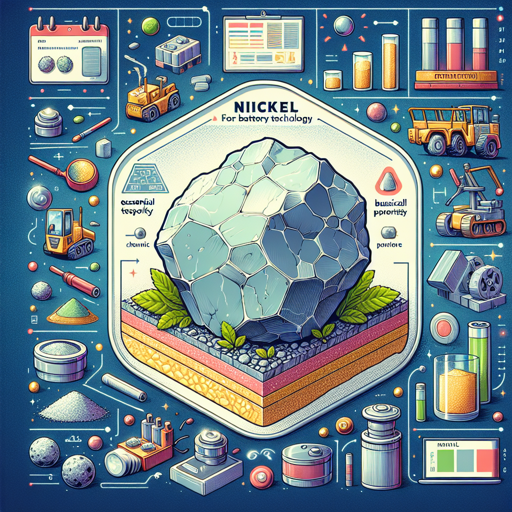Nickel: Powering Up the Future of Battery Production
Exploring the crucial role of nickel in advancing battery technology and its impact in the mining and minerals industry.

Introduction
In the heart of the earth lies an element quietly powering our modern lives: Nickel. This silvery-white lustrous metal, with a slight golden tinge, has become a cornerstone in the production of rechargeable batteries. As the world transitions towards renewable energy and electric vehicles, the demand for nickel has surged, positioning it as a vital player in the future of sustainable technology.
The Role of Nickel in Battery Production
Nickel-based batteries, particularly Nickel-Cobalt-Aluminum (NCA) and Nickel-Manganese-Cobalt (NMC), are the go-to choice for electric vehicles and large-scale energy storage systems. These batteries are favored for their high energy density, longer lifespan, and superior thermal stability.
The high energy density of nickel-based batteries allows them to store more power compared to other battery types of the same size. This makes them ideal for electric vehicles, which require long-lasting batteries to maximize their driving range.
Nickel also enhances the lifespan of a battery. With nickel, batteries can withstand more charge and discharge cycles before their capacity starts to degrade. This longevity is essential for applications like electric vehicles and renewable energy storage, where the battery needs to function efficiently over several years.
Furthermore, nickel improves the thermal stability of batteries. It helps them operate safely under high temperatures, reducing the risk of overheating and potential battery failure.
“Nickel is to a battery what flour is to a cake.”
- Elon Musk, CEO of Tesla
Nickel’s significance in battery production is aptly summed up by Elon Musk’s quote. Just as flour forms the backbone of a cake, nickel forms the backbone of a battery, providing the necessary properties to make it efficient, long-lasting, and safe.
Nickel Consumption in Battery Production: A Comparative Analysis
| Year | Nickel Consumption (in metric tons) |
|---|---|
| 2010 | 40,000 |
| 2015 | 70,000 |
| 2020 | 200,000 |
| 2025* | 800,000 |
*Projected consumption
The table above illustrates the increasing trend in nickel consumption for battery production. The rise from 40,000 metric tons in 2010 to an estimated 800,000 in 2025 underscores the growing significance of nickel in our energy-dependent society.
The Impact on Mining and Mineral Industries
The soaring demand for nickel has significant implications for the mining and mineral industries. Nickel mining operations are expanding globally, with Indonesia, the Philippines, and Russia being the top nickel-producing countries. This growth presents both challenges and opportunities.
On one hand, increased nickel mining poses environmental concerns, including habitat destruction, water pollution, and greenhouse gas emissions. On the other hand, it offers economic opportunities, creating jobs and contributing to the GDP of mining-dependent countries.
In response to these challenges, many mining companies are implementing sustainable mining practices, such as reducing water usage, rehabilitating mining sites, and leveraging renewable energy sources.
Learn more about sustainable mining practices here
Conclusion
Nickel, once a humble element hidden in the earth’s crust, has emerged as a critical component in the advancement of battery technology. As the demand for renewable energy and electric vehicles grows, so does the need for nickel. The mining and minerals industry is rising to this challenge, seeking to balance the increasing demand with sustainable practices. As we look towards a greener future, nickel will undoubtedly continue to play a pivotal role, powering not just our devices, but our drive towards sustainability.